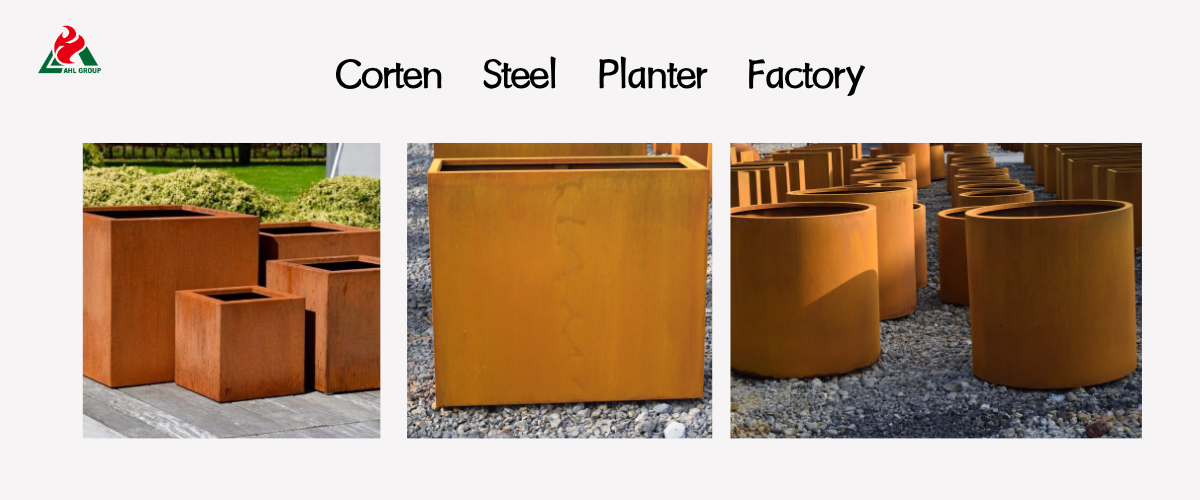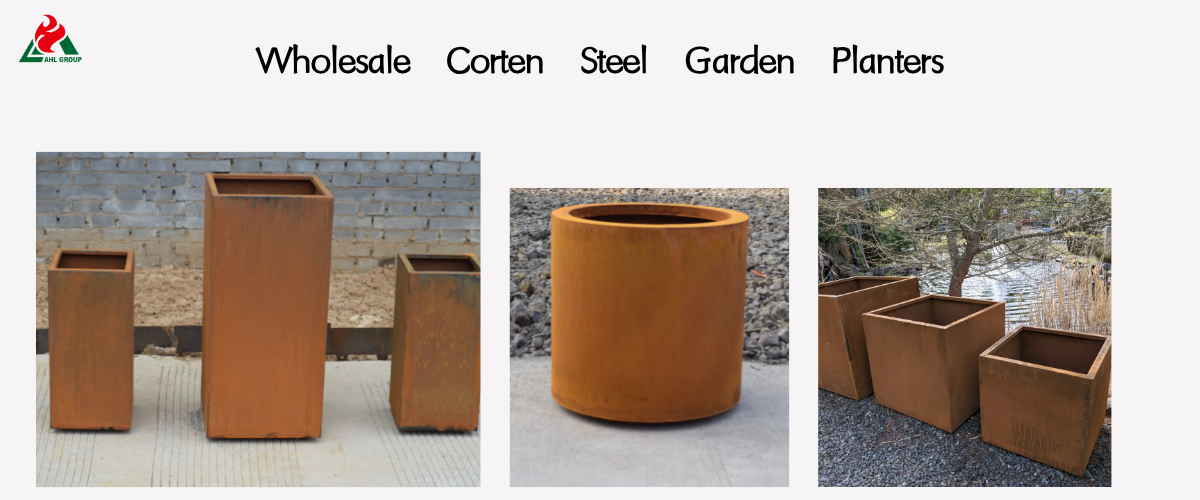In the realm of modern outdoor landscape design, material selection not only determines a space's aesthetic impact but also its longevity. Corten steel (also known as weathering steel) stands apart with its commitment to permanent outdoor presence. Featuring its signature rust-red patina, Corten steel planters are not seasonal decorations but enduring architectural fixtures designed to bloom year-round, transforming often bleak winter gardens into galleries of industrial elegance.
However, the true test of any outdoor fixture lies in its resilience against winter's harshest assaults—enduring freeze-thaw cycles, heavy snow loads, and the corrosive effects of road de-icing agents. As temperatures plummet below freezing, property owners and landscape architects often question whether this unique metal can maintain both structural integrity and visual appeal. AHL Group—a leading manufacturer of premium weathering steel products—addresses winter usage concerns comprehensively through this guide, confirming these metal planters as a sustainable, maintenance-free investment choice.

However, the true test of any outdoor fixture lies in its resilience against winter's harshest assaults—enduring freeze-thaw cycles, heavy snow loads, and the corrosive effects of road de-icing agents. As temperatures plummet below freezing, property owners and landscape architects often question whether this unique metal can maintain both structural integrity and visual appeal. AHL Group—a leading manufacturer of premium weathering steel products—addresses winter usage concerns comprehensively through this guide, confirming these metal planters as a sustainable, maintenance-free investment choice.

Winter Durability of Weathering Steel
The core advantage of choosing weathering steel planters to enhance outdoor spaces lies in their inherent structural resilience, engineered specifically for harsh climates. Unlike porous materials that crack when water absorbs and freezes, the composition of weathering steel ensures exceptional longevity, making it the preferred material for year-round outdoor use.
Understanding Weathering Steel's All-Weather Adaptability
The exceptional durability of weathering steel stems from its unique chemical composition—an alloy containing copper, chromium, and nickel. When exposed to natural environments, this composition promotes the formation of a protective rust layer. This rust-like barrier exhibits stability, non-porosity, and self-healing properties. Engineered to resist weathering, it shields the underlying steel from moisture, UV radiation, or extreme cold, preventing deep corrosion.
Weathering Steel's Exceptional Performance in Freezing Conditions
Weathering steel excels in freezing conditions, primarily due to its exceptional tensile strength and ductility. It maintains structural integrity and flexibility even at temperatures far below freezing. While terracotta or certain ceramics become brittle and crack due to water expansion during freezing, AHL Group's Corten steel planters, with their robust metallurgical properties, effectively resist such phenomena, easily withstanding internal pressures caused by frozen soil.
How Corten Steel Withstands Winter Elements
The way weathering steel interacts with winter elements—snow, ice, and persistent moisture—is precisely what underpins its reputation as a low-maintenance, durable outdoor solution.
Protective Rust Layer in Freeze-Thaw Cycles
The notorious freeze-thaw cycle is the primary enemy of many outdoor installations. For weathering steel, however, this cycle poses no threat to its protective layer. The rust layer adheres firmly to the steel surface through chemical bonds; repeated freezing and thawing does not cause it to flake, peel, or become structurally unstable. In fact, freeze-thaw cycles enhance the overall density and stability of the rust layer, maximizing its long-term corrosion resistance. A stable rust layer effectively blocks moisture penetration, preventing damage to the underlying metal.
Resistance to Snow, Ice, and Deicing Agents
• Snow and Ice Loads: The thick-gauge weathering steel used by AHL Group possesses exceptional structural strength, capable of withstanding heavy snow loads without bending or deformation.
• Road Salt: While high concentrations of chloride ions (present in road salt and de-icing agents) may temporarily alter the rust layer's appearance, weathering steel is inherently more resistant to salt corrosion than ordinary steel. This effect is typically limited to aesthetics—temporary whitening (salt efflorescence) or slight rust color changes—without compromising the metal's structural lifespan.
Structural Integrity in Low-Temperature Environments
The low-temperature toughness of weathering steel is a critical metric in its manufacturing process. Even under prolonged exposure to cold conditions, this material maintains exceptional impact resistance and strength. This makes it an ideal choice for permanent landscape components—structures that must preserve their form and function while completely avoiding the risk of structural failure caused by low temperatures.

Winter Preparation Best Practices of Corten Planters
Although weathering steel itself requires no frost protection, preparing your garden planter system ensures healthy plant growth and maintains the integrity of the containers.
Frost Protection Key: Optimize Drainage
Regardless of material, excellent drainage is central to winter planter care.
• Ensure Unobstructed Drainage: Before the first severe cold snap, thoroughly inspect all drainage holes to confirm they are completely clear. Blockages cause water accumulation, increasing root rot risk and creating unnecessary ice pressure.
• Elevate Planting Containers: Place small non-porous coasters or spacers beneath the container base to improve air circulation and ensure complete water drainage. This prevents prolonged exposure of the container bottom to cold, damp conditions.
Winter Soil and Plant Care Essentials
To protect plants and pot walls from extreme stress:
• Root insulation: Apply a thick layer of mulch over the soil surface to moderate temperature fluctuations and insulate perennial root systems.
• Select cold-hardy varieties: Ensure plants in outdoor Corten planters are rated one to two zones hardier than your local climate to compensate for insufficient ground insulation.
Position Adjustment in Harsh Environments
For extremely exposed sites or situations requiring reduced salt exposure:
• Shelter: If possible, relocate outdoor planters to more protected areas, such as near building walls, to minimize exposure to biting winds and heavy freezing rain.
• Avoid Eaves: Never place planter pots directly beneath roof eaves, where concentrated and persistent moisture exposure may delay the critical drying phase needed for patina formation.

Common Winter Concerns Addressed About Corten Steel Planter
Addressing specific concerns about metal materials in severe cold is crucial for clients considering custom weathering steel planters.
Q: Will the Steel Crack or Become Brittle?
No. Weathering steel maintains high tensile strength in cold weather due to its superior metallurgical properties, preventing catastrophic fractures or brittleness. Its design inherently resists thermal expansion and contraction stresses better than concrete or composite materials. This is precisely why AHL Group confidently supplies these products for diverse climates worldwide.
Q: Managing Frost Heave in Planters
The primary risk of frost heave stems from saturated soil. Following best drainage practices—ensuring drainage holes remain clear and metal planters are elevated—minimizes the available water for freezing. The structural integrity of thick-gauge weathering steel allows it to safely withstand residual pressure from frozen soil without deformation.
Q: Impact of Salts and De-icing Agents on the Patina
Chloride-based de-icing agents are the only winter factor that temporarily alters the patina's appearance, typically manifesting as bright orange streaks or white residue. This phenomenon is purely superficial and temporary. Key maintenance tip: When spring arrives, thoroughly rinse with clean water to remove salt residue. The natural weathering process will swiftly restore the patina's deep, uniform characteristic color.
Spring Recovery and Maintenance
The appeal of Corten steel garden planters lies in their minimal maintenance requirements. Spring upkeep involves only simple inspections and passive repairs.
Post-Winter Inspection Checklist
• Check for Blockages: Reconfirm all drainage outlets remain clear after freeze-thaw cycles.
• Rinse Exterior Surfaces: If the Corten planter came into contact with road de-icing salt, thoroughly rinse the outer surfaces with a pressure washer to neutralize and remove salt compounds.
• Check soil level: Replenish soil if settlement occurs during winter.
Restoring Appearance After Winter
No special sealants or treatments are required. Patina is a living surface. After winter, spring rain and sunlight naturally reactivate the oxidation-reduction process, rapidly and evenly restoring the patina's color and texture across the entire surface. AHL Group emphasizes that these landscape planters are self-maintaining, requiring no painting or sealing.

Conclusion: Optimize Your Outdoor Living Space with Corten Steel Planters
The answer is unequivocal: Corten steel planters are engineered for year-round outdoor use. They represent an exceptional permanent outdoor investment, withstanding the corrosive effects of extreme cold, freezing temperatures, and freeze-thaw cycles. These Corten metal planters are the ideal choice for diverse landscaping projects. By selecting AHL Group's premium products, you gain outdoor décor that combines enduring durability with stunning architectural beauty—a quality that continues to shine year after year.


